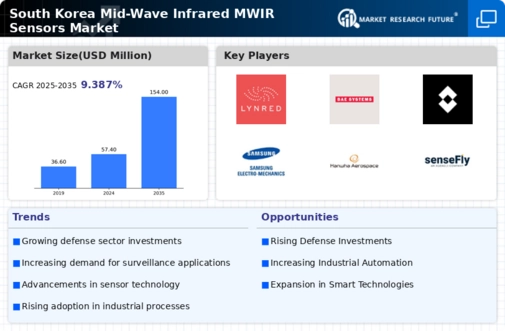Market Growth Projections
The Global South Korea Mid-Wave Infrared MWIR Sensors Market Industry is projected to experience robust growth over the coming years. With a market value expected to reach 750 USD Million in 2024 and potentially doubling to 1500 USD Million by 2035, the industry is on a promising trajectory. The anticipated CAGR of 6.5% from 2025 to 2035 indicates a strong upward trend, driven by various factors including technological advancements, increased defense spending, and broader industrial applications. This growth reflects the increasing reliance on MWIR sensors across multiple sectors, highlighting their critical role in modern technology.
Growing Demand in Defense Sector
The Global South Korea Mid-Wave Infrared MWIR Sensors Market Industry is experiencing heightened demand from the defense sector. The South Korean government has been investing significantly in modernizing its military capabilities, which includes the integration of advanced sensor technologies. This trend is expected to drive the market value to approximately 750 USD Million in 2024. The emphasis on surveillance, reconnaissance, and targeting systems necessitates the deployment of MWIR sensors, which are crucial for night vision and thermal imaging applications. As defense budgets continue to grow, the market is poised for substantial expansion.
Advancements in Sensor Technology
Technological advancements in MWIR sensors are propelling the Global South Korea Mid-Wave Infrared MWIR Sensors Market Industry forward. Innovations such as improved sensitivity, resolution, and miniaturization are enhancing the performance of these sensors. For instance, the development of uncooled MWIR sensors has made them more accessible for various applications, including industrial and commercial uses. This evolution in technology is likely to attract new investments and applications, thereby contributing to a projected market growth rate of 6.5% CAGR from 2025 to 2035. Enhanced capabilities are expected to broaden the scope of MWIR sensors across multiple sectors.
Emerging Applications in Healthcare
The Global South Korea Mid-Wave Infrared MWIR Sensors Market Industry is also expanding into the healthcare sector. The application of MWIR sensors in medical imaging and diagnostics is gaining traction, offering non-invasive methods for detecting various conditions. For instance, these sensors can be utilized for thermal imaging to monitor body temperature and detect anomalies. As the healthcare industry continues to innovate and seek advanced diagnostic tools, the demand for MWIR sensors is expected to rise. This emerging application area may contribute to the overall market growth, reflecting the versatility and adaptability of MWIR technology.
Rising Focus on Environmental Monitoring
The Global South Korea Mid-Wave Infrared MWIR Sensors Market Industry is increasingly influenced by a rising focus on environmental monitoring. Governments and organizations are prioritizing the tracking of emissions and pollutants, necessitating advanced sensing technologies. MWIR sensors are particularly effective in detecting gases and thermal emissions, making them invaluable for environmental assessments. This growing awareness of environmental issues is likely to drive demand for MWIR sensors across various sectors, including energy and manufacturing. As regulatory frameworks tighten, the market could see a significant uptick in adoption, further solidifying its relevance in the context of sustainability.
Increasing Adoption in Industrial Applications
The Global South Korea Mid-Wave Infrared MWIR Sensors Market Industry is witnessing increased adoption in industrial applications, particularly in manufacturing and quality control. Industries are leveraging MWIR sensors for non-destructive testing, thermal imaging, and process monitoring. This trend is driven by the need for enhanced efficiency and quality assurance in production processes. As industries continue to embrace automation and smart technologies, the demand for reliable sensing solutions is expected to rise. This shift may contribute to the market's growth trajectory, potentially reaching 1500 USD Million by 2035, as more sectors recognize the value of MWIR sensors.




















Leave a Comment